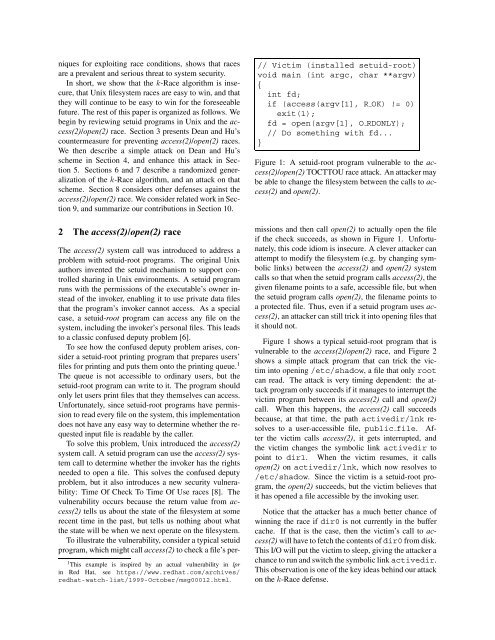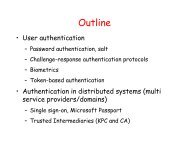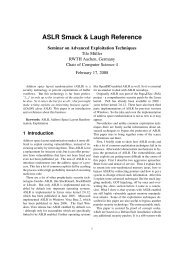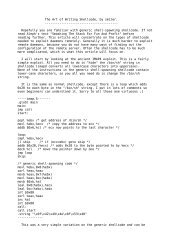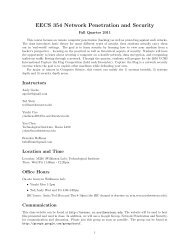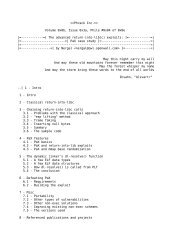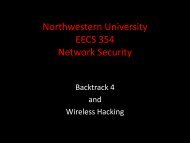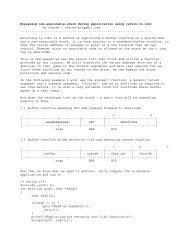Fixing Races for Fun and Profit: How to abuse atime - University of ...
Fixing Races for Fun and Profit: How to abuse atime - University of ...
Fixing Races for Fun and Profit: How to abuse atime - University of ...
You also want an ePaper? Increase the reach of your titles
YUMPU automatically turns print PDFs into web optimized ePapers that Google loves.
niques <strong>for</strong> exploiting race conditions, shows that races<br />
are a prevalent <strong>and</strong> serious threat <strong>to</strong> system security.<br />
In short, we show that the k-Race algorithm is insecure,<br />
that Unix filesystem races are easy <strong>to</strong> win, <strong>and</strong> that<br />
they will continue <strong>to</strong> be easy <strong>to</strong> win <strong>for</strong> the <strong>for</strong>eseeable<br />
future. The rest <strong>of</strong> this paper is organized as follows. We<br />
begin by reviewing setuid programs in Unix <strong>and</strong> the access(2)/open(2)<br />
race. Section 3 presents Dean <strong>and</strong> Hu’s<br />
countermeasure <strong>for</strong> preventing access(2)/open(2) races.<br />
We then describe a simple attack on Dean <strong>and</strong> Hu’s<br />
scheme in Section 4, <strong>and</strong> enhance this attack in Section<br />
5. Sections 6 <strong>and</strong> 7 describe a r<strong>and</strong>omized generalization<br />
<strong>of</strong> the k-Race algorithm, <strong>and</strong> an attack on that<br />
scheme. Section 8 considers other defenses against the<br />
access(2)/open(2) race. We consider related work in Section<br />
9, <strong>and</strong> summarize our contributions in Section 10.<br />
2 The access(2)/open(2) race<br />
The access(2) system call was introduced <strong>to</strong> address a<br />
problem with setuid-root programs. The original Unix<br />
authors invented the setuid mechanism <strong>to</strong> support controlled<br />
sharing in Unix environments. A setuid program<br />
runs with the permissions <strong>of</strong> the executable’s owner instead<br />
<strong>of</strong> the invoker, enabling it <strong>to</strong> use private data files<br />
that the program’s invoker cannot access. As a special<br />
case, a setuid-root program can access any file on the<br />
system, including the invoker’s personal files. This leads<br />
<strong>to</strong> a classic confused deputy problem [6].<br />
To see how the confused deputy problem arises, consider<br />
a setuid-root printing program that prepares users’<br />
files <strong>for</strong> printing <strong>and</strong> puts them on<strong>to</strong> the printing queue. 1<br />
The queue is not accessible <strong>to</strong> ordinary users, but the<br />
setuid-root program can write <strong>to</strong> it. The program should<br />
only let users print files that they themselves can access.<br />
Un<strong>for</strong>tunately, since setuid-root programs have permission<br />
<strong>to</strong> read every file on the system, this implementation<br />
does not have any easy way <strong>to</strong> determine whether the requested<br />
input file is readable by the caller.<br />
To solve this problem, Unix introduced the access(2)<br />
system call. A setuid program can use the access(2) system<br />
call <strong>to</strong> determine whether the invoker has the rights<br />
needed <strong>to</strong> open a file. This solves the confused deputy<br />
problem, but it also introduces a new security vulnerability:<br />
Time Of Check To Time Of Use races [8]. The<br />
vulnerability occurs because the return value from access(2)<br />
tells us about the state <strong>of</strong> the filesystem at some<br />
recent time in the past, but tells us nothing about what<br />
the state will be when we next operate on the filesystem.<br />
To illustrate the vulnerability, consider a typical setuid<br />
program, which might call access(2) <strong>to</strong> check a file’s per-<br />
1 This example is inspired by an actual vulnerability in lpr<br />
in Red Hat, see https://www.redhat.com/archives/<br />
redhat-watch-list/1999-Oc<strong>to</strong>ber/msg00012.html.<br />
// Victim (installed setuid-root)<br />
void main (int argc, char **argv)<br />
{<br />
int fd;<br />
if (access(argv[1], R OK) != 0)<br />
exit(1);<br />
fd = open(argv[1], O RDONLY);<br />
// Do something with fd...<br />
}<br />
Figure 1: A setuid-root program vulnerable <strong>to</strong> the access(2)/open(2)<br />
TOCTTOU race attack. An attacker may<br />
be able <strong>to</strong> change the filesystem between the calls <strong>to</strong> access(2)<br />
<strong>and</strong> open(2).<br />
missions <strong>and</strong> then call open(2) <strong>to</strong> actually open the file<br />
if the check succeeds, as shown in Figure 1. Un<strong>for</strong>tunately,<br />
this code idiom is insecure. A clever attacker can<br />
attempt <strong>to</strong> modify the filesystem (e.g. by changing symbolic<br />
links) between the access(2) <strong>and</strong> open(2) system<br />
calls so that when the setuid program calls access(2), the<br />
given filename points <strong>to</strong> a safe, accessible file, but when<br />
the setuid program calls open(2), the filename points <strong>to</strong><br />
a protected file. Thus, even if a setuid program uses access(2),<br />
an attacker can still trick it in<strong>to</strong> opening files that<br />
it should not.<br />
Figure 1 shows a typical setuid-root program that is<br />
vulnerable <strong>to</strong> the access(2)/open(2) race, <strong>and</strong> Figure 2<br />
shows a simple attack program that can trick the victim<br />
in<strong>to</strong> opening /etc/shadow, a file that only root<br />
can read. The attack is very timing dependent: the attack<br />
program only succeeds if it manages <strong>to</strong> interrupt the<br />
victim program between its access(2) call <strong>and</strong> open(2)<br />
call. When this happens, the access(2) call succeeds<br />
because, at that time, the path activedir/lnk resolves<br />
<strong>to</strong> a user-accessible file, public file. After<br />
the victim calls access(2), it gets interrupted, <strong>and</strong><br />
the victim changes the symbolic link activedir <strong>to</strong><br />
point <strong>to</strong> dir1. When the victim resumes, it calls<br />
open(2) on activedir/lnk, which now resolves <strong>to</strong><br />
/etc/shadow. Since the victim is a setuid-root program,<br />
the open(2) succeeds, but the victim believes that<br />
it has opened a file accessible by the invoking user.<br />
Notice that the attacker has a much better chance <strong>of</strong><br />
winning the race if dir0 is not currently in the buffer<br />
cache. If that is the case, then the victim’s call <strong>to</strong> access(2)<br />
will have <strong>to</strong> fetch the contents <strong>of</strong> dir0 from disk.<br />
This I/O will put the victim <strong>to</strong> sleep, giving the attacker a<br />
chance <strong>to</strong> run <strong>and</strong> switch the symbolic link activedir.<br />
This observation is one <strong>of</strong> the key ideas behind our attack<br />
on the k-Race defense.


